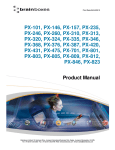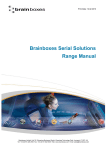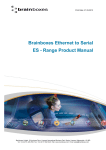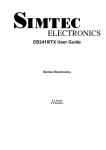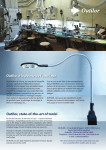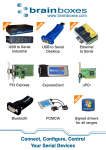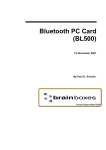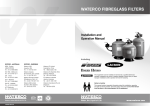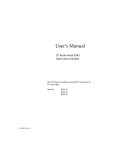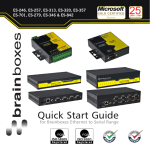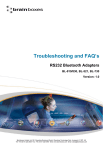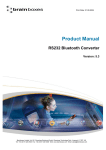Download Brainboxes PX-146
Transcript
Print Date:12/02/2010 PX-260, PX-701, PX-320, PX-324, PX-313, PX-346, PX-335, PX-146, PX-157, PX-475, PX-310, PX-368, PX-387, PX-376 Product Manual Brainboxes Limited, Unit 3C, Wavertree Boulevard South, Wavertree Technology Park, Liverpool, L7 9PF, UK Tel: +44 (0)151 220 2500 Fax: +44 (0)151 252 0446 Web: www.brainboxes.com Email: [email protected] Contents 1. Introduction .................................................................................................................................................... 4 1.1. The PCI Express PX- Range .................................................................................................................. 4 1.2. Supported Operating Systems................................................................................................................ 5 2. Installation Instructions .................................................................................................................................. 6 2.1. Windows XP and Windows Server 2003 Installation .............................................................................. 7 2.2. Windows Vista & Server 2008 64 & 32 bit Installation.......................................................................... 10 2.3. Windows 7/Server 2008 R2 .................................................................................................................. 13 3. Product Configuration .................................................................................................................................. 16 3.1. Finding your Brainboxes COM port....................................................................................................... 16 3.2. Changing your COM label..................................................................................................................... 17 3.3. Port Settings.......................................................................................................................................... 18 3.4. RS422/485 Settings .............................................................................................................................. 20 3.5. UART Settings ...................................................................................................................................... 22 3.6. Termination Resistors ........................................................................................................................... 24 4. Uninstallation – Windows Server 2008/Vista/Server 2003/XP .................................................................... 25 5. Boost.PCIe Driver Upgrade / Rollback ........................................................................................................ 28 5.1. Upgrading the Boost.PCIe Driver.......................................................................................................... 28 6. Troubleshooting and Testing ....................................................................................................................... 29 6.1. Installation problems ............................................................................................................................. 29 6.2. Communication Problems..................................................................................................................... 29 6.3. Testing your Serial COM port ............................................................................................................... 30 7. Lifetime Warranty and Support.................................................................................................................... 31 8. Technical Specifications .............................................................................................................................. 32 8.1. Supported Serial Settings ..................................................................................................................... 32 8.2. Device Pin-out....................................................................................................................................... 32 8.3. Company Accreditation ......................................................................................................................... 33 8.4. Europe – EU Declaration of Conformity................................................................................................ 34 8.5. WEEE Directive (Waste Electrical and Electronic Equipment) ............................................................. 34 8.6. RoHS Compliance................................................................................................................................. 34 PX Range Product Manual Version 2.0 © Copyright Brainboxes Limited 2010 Page 2 of 37 9. Copyright ..................................................................................................................................................... 36 10. Version History .......................................................................................................................................... 37 PX Range Product Manual Version 2.0 © Copyright Brainboxes Limited 2010 Page 3 of 37 1. Introduction 1.1. The PCI Express PX- Range The PX-Range are PCI Express (PCIe) cards providing several RS232 and RS-422/485 9-pin COM ports (see datasheets for alternatives) to any computer with a PCIe Lane. The advantage of Brainboxes PCI Express cards is that they can fit into any standard 1x, 4x, 8x or 16x PCIe Lane. Using the PCI Express card’s COM ports, all supporting 921,600 Baud, makes fast and effective communication between multiple devices simple. PX Range Product Manual Version 2.0 © Copyright Brainboxes Limited 2010 Page 4 of 37 1.2. Supported Operating Systems The PCI Express PX Range can be used with the following Microsoft Operating Systems with the supplied Boost.PCIe drivers; • Windows Server 2008 R2 • Windows 7 32-bit • Windows 7 64-bit • Windows Server 2008 32-bit • Windows Server 2008 64-bit • Windows Vista 32-bit • Windows Vista 64-bit • Windows Server 2003 32-bit • Windows Server 2003 64-bit • Windows XP 32-bit • Windows XP 64-bit • Windows 2000 Brainboxes PCI Express Drivers have undergone Microsoft testing with the PX RS232 and RS422/485 family. Upon passing these tests, the drivers were signed by Microsoft, as an indication of their quality and stability. PX Range Product Manual Version 2.0 © Copyright Brainboxes Limited 2010 Page 5 of 37 2. Installation Instructions PLEASE READ CAREFULLY • For RS232 Cards, there are TWO Installation steps to installing the Boost.PCIe driver: 1. CARD driver 2. PORT driver • For RS422/485 Cards, there are THREE Installation steps to installing the Boost.PCIe driver: 1. CARD driver 2. PORT driver 3. BASE SYSTEM DEVICE driver. This is the RS422/485 Controller • Each step will take you through a full installation using the Found New Hardware wizard. • Once the Card is installed, the Operating System will detect the COM Port. All you will need to do to install the COM Port is to run through the same installation steps as the Card. This also applies to the RS-422/485 Controller • Follow the Operating System specific instructions below to start the installation procedure. If you have any issues with installation, please follow the steps in Section 4: Uninstallation, then attempt to install again. If you still have issues, see Section 6: Troubleshooting and Testing PX Range Product Manual Version 2.0 © Copyright Brainboxes Limited 2010 Page 6 of 37 2.1. Windows XP and Windows Server 2003 Installation Note: Images below show a PX-260 4 Port RS232 device as an example. The same installation steps can be applied to all other products in the PCI Express range. 1. Turn off the PC (unplug from power socket) and insert the PCI Express Card into a free PCIe slot. 2. Turn the PC on. 3. Insert the Boost.PCIe CD 4. If you would like to install via Windows Update, select “Yes, this time only”. Otherwise Select ‘No, not this time’ to install from the CD and click next. PX Range Product Manual Version 2.0 © Copyright Brainboxes Limited 2010 Page 7 of 37 5. The Found New Hardware Wizard will then ask you to locate the software drivers. If you have chosen to search Windows Update, select “Install the software automatically (Recommended)”. This will take you to Step 7. If you wish to install from the Boost.PCIe CD, select “Install from a list or specific location (Advanced)” and click next to point to the CD drive. 6. Select to ‘Search for the best driver in these locations’ and then ‘Search removable media’, as shown below. Click Next PX Range Product Manual Version 2.0 © Copyright Brainboxes Limited 2010 Page 8 of 37 7. The Installer will copy across all the drivers and associated registry files. Click Finish when complete. 8. If you are installing a mulitport card, you will need to install each port manually following steps 4-7 when prompted for each port on your card. 9. If you are installing a 422/485 card, you will also need to install the “Base System Device”. This is the 422/485 Controller for your card. Follow steps 4-7 again when prompted. 10. Once installed, you can check the COM Number of the Port, by opening Device Manager (See Section 3.1: Finding your Brainboxes COM port). If you need to change the COM port number, see Section 3.2 Changing Your COM Label. PX Range Product Manual Version 2.0 © Copyright Brainboxes Limited 2010 Page 9 of 37 2.2. Windows Vista & Server 2008 64 & 32 bit Installation Note: Images below show a PX-260 4 Port RS232 device as an example. The same installation steps can be applied to all other products in the PX PCI Express range. 1. Turn off the PC (unplug from power socket) and insert the PCI Express Card into a free PCIe slot. 2. Turn the PC on. 3. Insert the Boost.PCIe CD 4. The Found New Hardware Wizard will come up. If your computer is set to check Windows Update Automatically for a driver, then it could take longer for this screen to pop up. 5. Select ‘Locate and install driver software’. 6. NB Vista will enter the Security Check to ensure that you have initiated the installation (and not some malicious program). Click Continue PX Range Product Manual Version 2.0 © Copyright Brainboxes Limited 2010 Page 10 of 37 7. If you would like to install via Windows Update, select “Yes, this time only”. This will take you to Step 9. Otherwise select ‘Don’t search online’ to install from the CD. 8. The Found New Hardware Wizard will then ask you to locate the software drivers. Ensure that the CD is in the drive and click Next PX Range Product Manual Version 2.0 © Copyright Brainboxes Limited 2010 Page 11 of 37 9. Once the driver has been installed, click Close. • If you are installing a mulitport card, the Operating System will install each subsequent Serial Port automatically. • If you are installing a 422/485 card, you will also need to install the “Base System Device”. This is the 422/485 Controller for your card. Follow steps 4-9 again when prompted. • Once installed, you can check the COM Number of the Port, by opening Device Manager (See Section 3.1: Finding your Brainboxes COM port). If you need to change the COM port number, see Section 3.2 Changing Your COM Label. PX Range Product Manual Version 2.0 © Copyright Brainboxes Limited 2010 Page 12 of 37 2.3. Windows 7/Server 2008 R2 Note: The following installation instructions use a PX-346, but the installation instructions are the same for any PX card. 1. When you boot up your computer on Windows 7, Windows update will automatically search for the latest drivers. If you have a connection to the internet, the drivers will be installed and the device will be ready to use. 2. If there is no connection to the internet or the drivers can’t be found, a message will appear to tell you that device driver software was not successfully installed. 3. To install the drivers Device manager will need to be opened. To open device manager go to the control panel, system, hardware tab, then click on the device manager button. 4. Once this is open you will see the yellow ! icon in the other devices node. Right click on the device and click on update driver software. PX Range Product Manual Version 2.0 © Copyright Brainboxes Limited 2010 Page 13 of 37 5. If your Brainboxes card came with a CD insert it now and select to search automatically and the driver software will be found and installed. Skip to step If not and you have a folder with the drivers, select to browse your computer for the drivers. 6. Select the folder which contains the drivers that you want to install for your device. 7. The drivers will then be installed for the card. PX Range Product Manual Version 2.0 © Copyright Brainboxes Limited 2010 Page 14 of 37 8. You will then need to install the Base System Device (RS422/485 devices only) and then install all of the Serial ports using the same steps as above. 9. Once you have installed one of the ports you can scan for hardware changes and the other Serial Ports will be installed automatically. PX Range Product Manual Version 2.0 © Copyright Brainboxes Limited 2010 Page 15 of 37 3. Product Configuration Note: Images below show a PX-260 4 Port RS232 device as an example. The same steps can be applied to all other products in the PX PCI Express range. 3.1. Finding your Brainboxes COM port. • Open Device Manager (Found by Right Clicking on My Computer and clicking Manage. Then Select Device Manager from the left hand pane.) For Server 2008 users, Device Manager is found within Diagnostics in Server Manager. • Find the Brainboxes Serial Port entry in Device manager. (Found under the ‘Ports’ section) • The Brainboxes Serial Port entry displays the current COM number in brackets after the name. (This is usually COM3 following install, but may be different if other serial devices have been installed in the past) • To change your COM label, see Section 3.2: Changing your COM label PX Range Product Manual Version 2.0 © Copyright Brainboxes Limited 2010 Page 16 of 37 3.2. Changing your COM label • If you need to change the COM label, Double click on the Port entry in Device Manager • Click on the ‘Port Settings’ tab and click Advanced • A new COM Port label can be selected from the “Com Port Number” dropdown menu. PX Range Product Manual Version 2.0 © Copyright Brainboxes Limited 2010 Page 17 of 37 • If the COM Port number is labelled “in use”, it is either currently used by a COM Port present on the system, or is reserved for a device which is not currently present. It is possible to select this COM number and force the change, if you are sure it is not required by any other device. 3.3. Port Settings The Port Settings allow you to set Default or Override Settings for the serial communication and how to deal with incoming hardware handshaking events. • To open ‘Port Settings’, open device manager and Double Click on the Brainboxes COM Port Entry under the ‘Ports’ section • Then Click on the ‘Port Settings’ tab. PX Range Product Manual Version 2.0 © Copyright Brainboxes Limited 2010 Page 18 of 37 • All options can be selected from the Dropdown Menus. In addition, you can enter a non-standard value into the Baud rate NB – Once the desired settings have been achieved, you must click OK to activate them. At anytime click the ‘Restore Default’ button to return to the original setup. Default / Override Settings • • The “Default Settings” will be set if an application does not specify the serial settings when it opens the COM Port. o This is sometimes the case with old Legacy applications and you will need to choose these settings to match the communications that you wish to use. o The majority of Applications will specify what Serial Settings they wish to use. In this case, it will not matter what the Default settings are, as the Port will be opened with the Application’s Settings. When the ‘Override’ box is checked next to the Default Setting, the Port will communicate at this setting whether an application has requested it or not. o For example, this will enable you to force baud rates that your application does not allow you to select. This can be useful for interfacing to equipment which uses higher baud rates or unusual baud rates, which your application does not support. o In a case where you want to use hardware handshaking, but your application is not capable, you can select RTS / CTS Always True – Hardware state ignored and choose to Override it. o NB with the use of Override Settings, you need to ensure that the equipment you are connecting to is setup to match the communications settings you are forcing. CTS / DSR Always True • CTS and DSR are incoming hardware handshaking lines. This means they receive signals from the connected device which tell the ExpressCard when it is and isn’t OK to send data. o Sometimes these signals may want to be ignored. By forcing CTS or DSR True, the ExpressCard will ignore those signals and always send data. PX Range Product Manual Version 2.0 © Copyright Brainboxes Limited 2010 Page 19 of 37 These settings are especially helpful when CTS and DSR are not physically connected (such as in a 3 wire setup) and it is not acceptable for the data flow to stop and start due to arbitrary variances on the unconnected signal lines. 3.4. RS422/485 Settings For RS422/485 products only, there is an additional tab in the Advanced Settings to allow you to change duplex mode. • The drop down list allows users to choose the desired RS422/485 operations mode. • Select “RS422 full duplex mode” for Full Duplex communications. • Select “RS485 half duplex autogating mode” for Half Duplex communications. • For further details on wiring, see Section 8.2: Device Pinout • Restore Defaults: Pressing this button will reset all settings on this Property Page back to the factory defaults of this device. The default settings for this Property Page are “RS422 full duplex mode”. Background Information: • DTR/DSR Handshaking is not available on 422/485 devices. • Full Duplex Mode This mode is generally used between one transmitter / receiver to only one other transmitter / receiver, but it is possible for each output to drive up to 10 receivers. Generally, in RS422 systems, all 8 signal lines from the 9 pin D connector participate in the data transfer sequence. Thus 4 twisted pair cables are used. One twisted pair carries the TXD data outwards, one pair brings the RXD data inward, another pair carries the RTS handshaking signal PX Range Product Manual Version 2.0 © Copyright Brainboxes Limited 2010 Page 20 of 37 outwards, and the fourth pair brings the CTS handshaking signal inwards. There is no need to carry the ground from one device to another. • Half Duplex Autogating Mode The RS485 standard is similar to the RS422 standard upon which it is based. The main difference is that up to 32 transmitter / receiver pairs may be present on the line at one time. Although the card uses a 9 pin D connector, generally not all the lines are used for RS485 systems. The RTS+/- and CTS+/- lines, though driven by the card, are usually not connected. In two wire HalfDuplex configuration, the TXD+ line is connected to RXD+, whilst the TXD- line is connected to RXD-. Only one pair of twisted wire cable is used in RS485 Half Duplex communication. These are the two main wiring schemes: o RS485 One Talker Many Listeners (Half Duplex) o RS485 Many Talkers Many Listeners (Half Duplex) Please see Section 8.2: Device Pinout for wiring diagrams. PX Range Product Manual Version 2.0 © Copyright Brainboxes Limited 2010 Page 21 of 37 3.5. UART Settings The UART settings for the Brainboxes COM Port allow you to get the best performance from your device and system. There are two choices, dependant on whether minimal CPU usage or Data Latency (delay) is the main concern. The default settings have been carefully selected and should provide great performance for the majority of users. The UART Settings will help if you need to lower the CPU usage, or your application is timing critical and requires a lower Data Latency • To open Advanced Settings, open the Port Settings (as described in section 3.2) and click the Advanced button • Select the ‘UART Settings’ tab. Receive Trigger Level: • This slider allows you to choose how much incoming data is stored in the Receive FIFO before it gets processed by the driver. • Processing the data takes a small amount of CPU time, so doing this frequently will increase CPU Usage, but it will also decrease the latency at which data is delivered to the application. Choosing the right value is a trade-off between CPU Usage and Latency. PX Range Product Manual Version 2.0 © Copyright Brainboxes Limited 2010 Page 22 of 37 • Setting this value very low will result in a high number of interrupts, and therefore increased CPU Usage, as well as short latency times between the reception of the data by the UART chip and the delivery to the application. Choosing a high value has the opposite effect. • If the Receive Trigger Level is chosen very high, and data is continuously streaming into the UART's FIFO, then this might result in data getting lost due to a FIFO Overrun. This is caused by the reaction time of the Operating System and driver to the interrupt. If this reaction time is longer than it takes to fill up the remaining space in the FIFO, then overrun can occur. To prevent this, choose a slightly lower Receive Trigger Level, and use Flow Control. • The slider allows choosing values from 1% to 100% of the Receive FIFO size. Transmit Trigger Level: • This slider allows you to choose when the Transmit FIFO is re-filled with data. If a low value is chosen, little or no data is left in the Transmit FIFO at the time of the re-fill. The higher the value, the more data will be in the FIFO. • Re-filling the Transmit FIFO before it runs empty has the advantage that the small processing time required to generate the interrupt notification to the driver and putting data into the FIFO will not have the effect of a gap appearing in the data stream on the transmission line. • It is not common to choose high values for this slider, as the potential transmission gap is easily bridged, even if values are chosen in the lower part of the slider. Higher levels increase the amounts of hardware interrupts generated, and hence increase CPU usage. • The slider allows choosing values from 0% to 100% of the Transmit FIFO size. Flow Control Trigger Level • The slider only takes affect if any type of flow control was selected by the application that opened the COM port. • This slider allows you to choose when the flow control state changes (RTS, DTR, in-band flow control). If the amount of received data reaches the Flow Control Trigger Level, any active flow control mechanism is set to the 'do not send' state. Once the amount of received data falls again below this level, all active flow control mechanisms are returned to the 'send data' state. • Depending how handshaking is implemented on the device at the other side of the cable, it is possible that some data is still transmitted to our UART even after handshaking has been turned off. Setting very high Flow Control Trigger Levels might in this case result in a FIFO overrun, and hence the loss of data. • It is not common to choose low values for this slider, as this increases the amount of handshaking changes on the line. That might increase the processing overhead on the remote device, and result in gaps in the data stream, thus reducing data throughput. Usually values are chosen in the higher part of the slider. • The slider allows choosing values from 1% to 100% of the Receive FIFO size. Pressing the “Restore Defaults” button will reset all settings on this Property Page to the factory defaults of this device. PX Range Product Manual Version 2.0 © Copyright Brainboxes Limited 2010 Page 23 of 37 3.6. Termination Resistors This RS422/485 termination circuit is based on the recommendation of Texas Instruments, and uses resistors to provide line termination Rt, bus-idle failsafing (biasing) Rb and bus-shorted failsafing, Rf. However, this circuit may not be suitable for all RS-485 bus systems. Whilst the circuit includes line termination to prevent the data signal being reflected, this termination should only be present at each end of a bus and not at any intermediate nodes. Also, while this circuit ensures that our PX cards are properly biased when the bus is idle, this circuit may not provide sufficient bias for any nodes (ie external RS485 devices) which have their receivers connected directly to the D+ and D- lines. If you do have RS485 devices whose receivers are connected directly to the D+ and D- lines, you may need to add a couple of resistors to your bus, from D- to ground and from D+ to a positive supply, with a resistance sufficient to give at least 0.2V between D+ and D- when the bus is idle. PX Range Product Manual Version 2.0 © Copyright Brainboxes Limited 2010 Page 24 of 37 4. Uninstallation – Windows Server 2008/Vista/Server 2003/XP To uninstall the device, please ensure the PCI Express Card is present on the PC. • Open Control Panel, and then open “Add or Remove Programs”. In Vista, this will be called “Programs & Features” PX Range Product Manual Version 2.0 © Copyright Brainboxes Limited 2010 Page 25 of 37 • The Brainboxes Uninstallation wizard will launch, which will remove all driver files and associated registry entries. Just click Next on each page of the Wizard. When the drivers have been uninstalled, click Finish. PX Range Product Manual Version 2.0 © Copyright Brainboxes Limited 2010 Page 26 of 37 • Once finished, check Device Manager to ensure all Ports have been removed from the system. • You may now power down the PC and unplug your PCI Express Card. • To reinstall the software, o Simply Right Click the “Ports” entry in Device Manager and select “Scan for Hardware Changes”. Windows should find the ports and launch the Found New Hardware wizard. Follow the installation instructions as in Section 2 to reinstall o Alternatively, restart the PC to launch the Found New Hardware Wizard PX Range Product Manual Version 2.0 © Copyright Brainboxes Limited 2010 Page 27 of 37 5. Boost.PCIe Driver Upgrade / Rollback There are several parts to the Boost.PCIe, driver: For RS232: Example • Card driver: “Brainboxes PCIe 4 Port RS232 Serial Card (PX-260)” • Port driver: “Brainboxes RS232 Serial Port (COM3)”. For RS422/485 Example • Card driver: “Brainboxes PCIe 2 Port RS422/485 Serial Card (PX-313)” • 422/485 driver : “Brainboxes RS422/485 Controller “ • Port driver: “Brainboxes RS422/485 Serial Port (COM3)”. NB If you need to upgrade or roll back the Boost.PCIe driver, we recommend to completely uninstall the existing drivers first, and then to install the new drivers from fresh. This will restore all settings to factory default. However, if you instead wish to retain your settings, you can use the ‘Update Driver’ or “RollBack” in Device Manager for upgrading/rolling back the Boost.PCIe driver. 5.1. Upgrading the Boost.PCIe Driver i. Go to Device Manager and Right Click on the Serial Card entry (Found under Multiport Serial Adapters – see image below) ii. Select Upgrade Driver. This will launch the Found New Hardware Wizard. Follow the on screen instructions and point to the location of the new driver package. NB: It is only possible to upgrade the Boost.PCIe driver via the Serial Card entry in Device Manager and not the Serial Port entry. The upgrade process will automatically upgrade the Port driver. PX Range Product Manual Version 2.0 © Copyright Brainboxes Limited 2010 Page 28 of 37 6. Troubleshooting and Testing 6.1. Installation problems • Check the PCI Express Card is correctly installed, and the Ports appear in Device Manager without any errors (Errors are indicted by a yellow exclamation mark) • If the installation did not complete or shows any error messages then restart the computer. • If Device Manager is still showing error messages, it is wise to uninstall and re-install. This should cure issues such as Resource Conflicts or failed installations. See Section 5: Uninstallation and Section 2: Installation Instructions. • If the problem is still present after trying the above, try the following to help narrow down the problem. 1. A different PCIe Slot 2. A different PC • Should the problem still persist, please contact Brainboxes Technical Support 6.2. Communication Problems If you are experiencing communication problems: • Check the PCI Express Card is correctly installed, and the Ports appear in Device Manager without any errors (Errors are indicted by a yellow exclamation mark). If there are any errors follow Section 6.1. • Perform a loopback: A loopback test will verify that your card is able to Transmit and Receive Data. The Transmit and Receive lines will need to be connected so that any data sent out of the card is then received back on the same Port. Please use the following to help perform a loopback • o Brainboxes SerialTest Application: Click here to Launch Loopback test application o HyperTerminal application: Testing Serial Cards with HyperTerminal procedure Please contact Brainboxes Technical Support with your Loopback test result should the problem still persist with your application. PX Range Product Manual Version 2.0 © Copyright Brainboxes Limited 2010 Page 29 of 37 6.3. Testing your Serial COM port To test your Brainboxes COM port works correctly you can use the Serial Test application. It is a simple application which will guide you through the steps to check that your Brainboxes COM port is working correctly. You will need to select the COM port you want to test, and connect a loopback connector to transmit and receive pins of the respected COM port. You will then be given a result as to whether the test has passed or failed. PX Range Product Manual Version 2.0 © Copyright Brainboxes Limited 2010 Page 30 of 37 7. Lifetime Warranty and Support To receive the lifetime Warranty, you need to register your product with us using our online form. NB: this must be done within 28 days of Purchase. Lifetime Warranty Sign up * Terms and Conditions are available online. Standard warranty period is 3 years if a product is not registered. Since 1983, Brainboxes have designed, tested and manufactured our products all under one Roof. One of our greatest strengths is in after sales service. Technical Support is provided by members of our Test Team, who know our products inside out and have direct access to the chip and board designers as well as the technicians who built and tested your product. If you have any issues, questions or suggestions about our Products and Services, then please contact us. Technical Support is free*. As long as you have a Brainboxes Product we will be happy to help, even if it’s discontinued or out of warranty. Excellent Customer Service, just as it should be. For the quickest solution to your issue, if you email us, please include as much detail of your setup and the fault you are experiencing. * Standard rate call charges for phone support apply. Email Technical Support: [email protected] Sales Enquiries: [email protected] Telephone You can speak to Brainboxes Support or Sales teams direct, Monday – Friday, 9am to 5pm (UK time) Tel: +44 (0)151 220 2500 PX Range Product Manual Version 2.0 © Copyright Brainboxes Limited 2010 Page 31 of 37 8. Technical Specifications 8.1. Supported Serial Settings Serial Setting Baud Rate Data Bits Parity Stop Bits Handshaking Break Up to 921,600 5,6,7 or 8 None, Odd, Even, Mark & Space 1, 1.5 or 2 RTS/CTS DTR/DSR Xon/Xoff Supported 8.2. Device Pin-out 8.2.1. RS232 Devices 8.2.2. RS422/485 Devices PLEASE NOTE: • DTR/DSR Handshaking is not available on RS422/485 devices • For RS422 FULL Duplex Communications, please note the pin outs above. • To achieve RS485 Half Duplex Communications, using two wires for communication, Pins 1 and 6, 2 and 7 must be physically shorted. • Once your wiring is setup, you will also need to set the card to FULL or HALF Duplex mode in the software. For further details, see Section 3.4: RS422/485 Settings Regulatory Approvals / Compliance For up to date details of global certifications, please check the product datasheet on the Brainboxes website. PX Range Product Manual Version 2.0 © Copyright Brainboxes Limited 2010 Page 32 of 37 8.2.3. Pinout for 44Way D-connector split cable for PX-260/701/346/335/368 8.3. Company Accreditation Brainboxes achieved accreditation to the ISO14001 environmental standard early 2008. This globally recognised standard ensures Brainboxes can demonstrate effective management of all its environmental impacts, together with a process of continuous improvement. Brainboxes have also been an ISO9001 registered company since 1994. This has ensured that Brainboxes products, right from design to manufacture, have been produced to the highest standards. We operate this Quality Management System through out the company, and it is subject to regular external surveillance visits. Brainboxes have always been aware of the need to continually review company processes and has been working with National Quality Assurance (www.nqa.com) since 1994, helping the company to create and maintain internationally recognised accreditation standards. Linked with our Lean and Six Sigma techniques, we believe we have the most reliable products on the market, and to back this up we are offering a Lifetime Warranty* on all our Serial Products. PX Range Product Manual Version 2.0 © Copyright Brainboxes Limited 2010 Page 33 of 37 8.4. Europe – EU Declaration of Conformity The PX PCIe Card devices conform to the protection requirements of European Council Directive 2004/108/EC The products are designed to meet the standards detailed below. The Declaration of Conformity and supporting Technical Construction File is available by request from Brainboxes. EN 55022:1998 A2:2003 Class A EN 55024:1998 A2:2003 Class A Information technology equipment — Radio disturbance characteristics — Limits and methods of measurement Information technology equipment — Immunity characteristics — Limits and methods of measurement 8.5. WEEE Directive (Waste Electrical and Electronic Equipment) The WEEE Directive 2004/96/EC came into force, in the UK, at the beginning of 2007. Customer Responsibilities You are encouraged to dispose of WEEE in an environmentally friendly way. This can be done through your local civic amenities site, an approved treatment facility or alternatively through a relevant compliance scheme. Brainboxes’ Responsibilities Brainboxes has a legal responsibility, as producer, to provide a free of charge collection service to our customers for our obligated WEEE. Brainboxes is defined as a producer under the WEEE Regulations because we sell own brand Electrical & Electronic Equipment (EEE) in the UK. Our WEEE Producer Registration Number is WEE/AH0004XR. For more information, click here. For details of our WEEE recovery service options, please see our Website, or email us at: [email protected] 8.6. RoHS Compliance All Brainboxes Serial and Bluetooth products are fully RoHS compliant. Brainboxes identified at an early stage the importance of rapid compliance to RoHS guidelines and established a project team to actively manage the transition. The initial step in the process was to use our close relationships with suppliers to ensure early access to RoHS compliant components for all of our Bluetooth and Serial Products. In addition, the project team worked to ensure that our manufacturing processes meet all RoHS requirements well in advance of the deadline. To verify supplier declarations on RoHS compliancy, we have also sent fully built products to an external test house for X-Ray Fluoresence testing on components, using the Fischerscope X Ray system XDAL. This technique is capable of determining percentages of different elements and is accurate to 0.1% Wt. PX Range Product Manual Version 2.0 © Copyright Brainboxes Limited 2010 Page 34 of 37 RoHS Compliant Brainboxes products have been available since January 2005. What is the RoHS Directive? The RoHS directive (2002/95/EC the Restriction of the use of certain Hazardous Substances in Electrical and Electronic Equipment) prohibits the sale of electrical and electronic equipment containing hazardous substances. A list of these hazardous substances includes lead, cadmium, mercury, hexavalent chromium, polybrominated biphenyls and polybrominated diphenylethers. RoHS affects each and every electronics manufacturer, directly or indirectly, regardless of geographical location or the equipment they produce. PX Range Product Manual Version 2.0 © Copyright Brainboxes Limited 2010 Page 35 of 37 9. Copyright Copyright © 1985-2010 Brainboxes Ltd All rights reserved. No part of this hardware, circuitry or manual may be duplicated, copied, transmitted or reproduced in any way without the prior consent of the Manufacturer PX Range Product Manual Version 2.0 © Copyright Brainboxes Limited 2010 Page 36 of 37 10. Version History Version Date Author 2.0 15/12/08 AH Manual for first release of Brainboxes fully fledged PCI Express serial drivers. 2.2 11/02/10 BH Added Windows 7 and Terminating resistors information. PX Range Product Manual Checked By Comments Version 2.0 © Copyright Brainboxes Limited 2010 Page 37 of 37





































